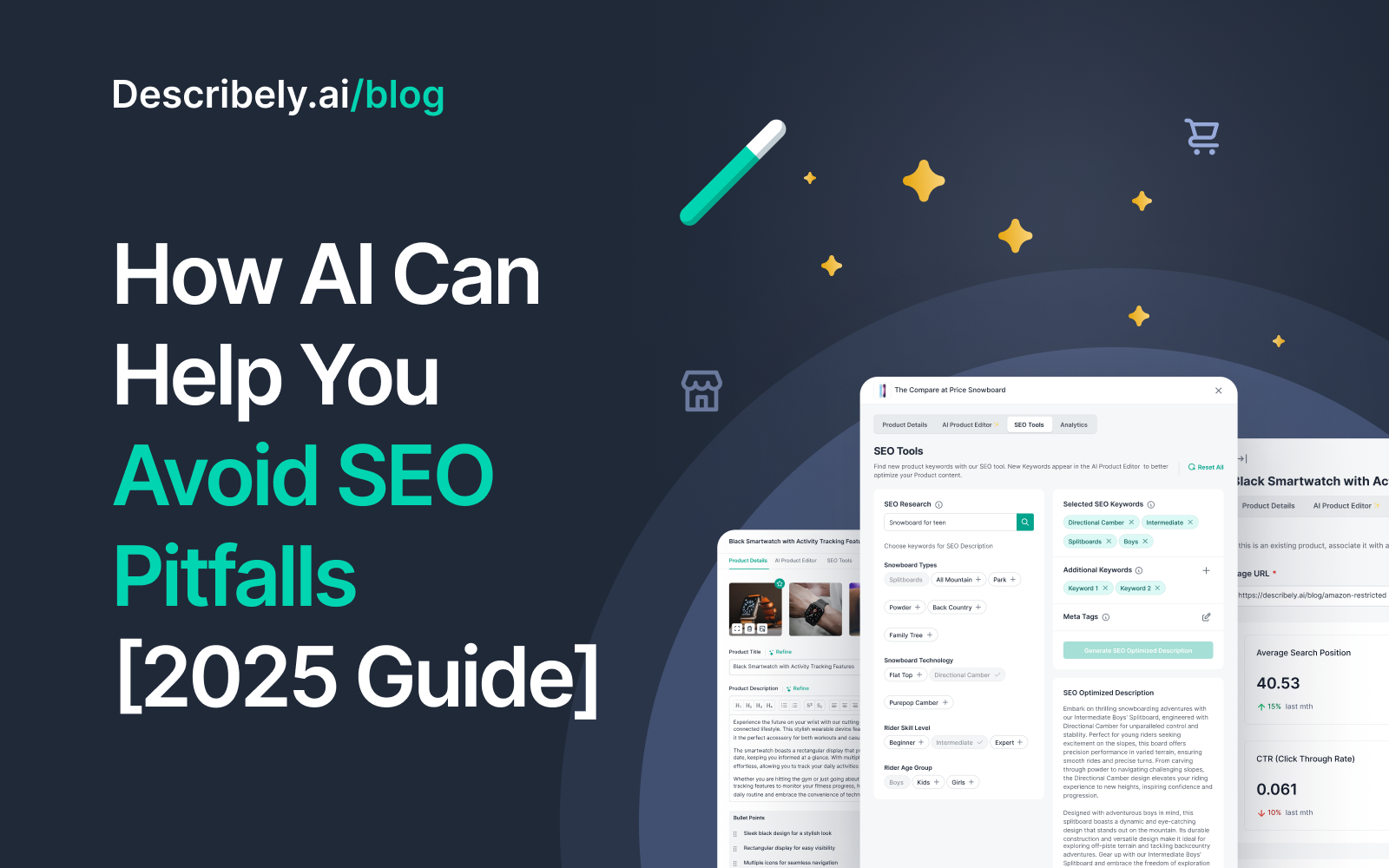
3 Ways AI Helps Retailers Overcome the Challenges of Writing eCommerce Product Content at Scale
If you’re at the helm of an eCommerce content team, you understand the Herculean task of churning out hundreds, if not thousands, of eCommerce product descriptions each week.
From the grind of edits and rewrites to the tangible costs and writer burnout, these challenges can gnaw at efficiency and disrupt your workflow.
Yet, thanks to major strides in technology a game-changer has emerged — artificial intelligence.
AI’s capabilities are not just theories; big retailers like Target AU are harnessing AI to revolutionize the way they create product content on a massive scale.
In this post, I’m not just going to talk about AI’s potential—I’m going to walk you through the tangible ways AI will help your team overcome the challenges they face when creating eCommerce product content at scale, along with examples.
Let’s dive in!
Challenge #1: The Herculean task of juggling hundreds to thousands of product descriptions
Let’s be real — crafting high-quality, SEO-optimized product descriptions isn’t a walk in the park for any eCommerce team.
Each piece must be rich in accurate product details, showcase compelling images, include keywords and let’s not forget about those dreaded meta descriptions. It’s manageable for a few items, but what about hundreds or thousands per week?
It truly becomes a Herculean Task.

And in the realms of beauty and fashion, home decor, furniture, big-box retailers, this is the all-too-common reality. Without systems and processes, efficiency can quickly begin to take a hit, especially on a small team.
Take Target AU’s scenario: five writers, each tasked with generating content for 250 products weekly. That’s over 1,000 new descriptions needed without fail. A monstrous task, sure to burden even the most stellar of teams. This is the overwhelming norm, not just for them but for countless eCommerce teams.
Cue AI to the rescue.
How AI Can Help
With the right touch, AI tools like Describely.ai allows teams to not only automatically generate product content, but also do it across 100’s to 1,000’s of products in bulk, all at once.
Picture this:
Let’s say that you need to create unique and creative product listings for different Bike Light Products — 1) 1200 LED Bike Light, 2) PowerGlow Pro Bike Light, and 3) Bike Light Straps.
Just give Describely’s AI some basic info then it will generate unique descriptions in bulk for each, resulting in three unique and highly optimized listings.

What once required hours of writing and editing can now be accomplished in mere moments, across your entire catalog, all thanks to AI.
This means a significant time and cost savings—resources now unleashed for more high-impact efforts.
Challenge #2: Dodging the editing inferno when working with contractors
Expanding your team with new hires, contractors, or agencies is a go-to strategy for scaling product description writing.
While this approach brings in fresh talent and a major time savings, it’s not without its drawbacks, because let’s face it — your in-house brand knowledge is nuanced. It’s shaped by your brand’s story, your audience’s preferences, and insider understanding of your market positioning.
At Describely, the biggest challenge that we hear around using contractors and agencies is that despite their expertise, they require a ramp-up period—to tailor their copy to your unique brand voice, adhere to your specific legal requirements, and truly ‘get’ your tone.
This initial phase involves intense collaborative editing, drafting meticulous guidelines, and frequent touch points. This can ignite an editing blaze that consumes precious time and resources — what we call the editing inferno.

How AI Can Help
Enter AI Rules
With custom rule-sets you get complete control over every aspect of your product descriptions — including tone, title, length, and meta descriptions.
For example, suppose your team is creating a product description for a new product, say, a tennis board. And imagine that this is for a sports retailer that has a fun and adventurous brand.
Using AI Rules you can set a custom rule-set to: ‘fun and adventurous’ inside of Describely.ai.

From there, the AI will apply that tone to your generated description. Here’s an example of the output.

“Unlock your tennis potential with our revolutionary Tennis Board. This state-of-the-art board will propel your skills to new heights, allowing you to conquer ambitious sports challenges with ease. Designed to improve your technique, speed, and accuracy, this board is your key to tennis mastery. Whether you’re a beginner or a seasoned player, the Tennis Board will revolutionize your training sessions and elevate your game. Prepare to dominate the court and leave your opponents in awe.“
As Helen from Target AU highlights, “AI Rules reduces the need for extensive fine-tuning and editing.”
She noted that with AI Rules, “Target AU achieves approximately 98% accuracy in their product descriptions.”
It’s important to emphasize that the goal here is not to replace human writers with AI, but rather to enhance the capabilities of your team.
By using AI as a supportive tool, you can decrease editing cycles, accelerate the process of getting products online, and ultimately boost ROI by freeing up valuable time. This approach not only streamlines workflow but also elevates the overall quality of your product content, leading to more sales.
Challenge #3: Wasting time and money scavenging the web for products with sparse details
If you’re managing an eCommerce content team, you know the drill. Suppliers send over a new product, and all you get is a name. Or maybe you’re tasked with launching a novel item with zero descriptions in the pipeline.
Trust me, At Describely we hear your collective sighs.
The hunt for product details is a notorious time sink and revenue eater for eCommerce teams everywhere.
To paint a picture, retailers spend huge sums of money annually due to this very issue: product enrichment tools draining budgets, manpower diverted into data-detective work, or your dedicated team members disappearing down rabbit holes. Neither option is kind to your bottom line.
Consider the stakes — putting up products with meager or incorrect details can sting twice.
For example, a Nielsen Norman Group study recently found that roughly 20% of failed purchases derive from unclear or missing product information. In addition, poorly crafted or absent product descriptions will pass over bountiful SEO ranking chances like a ghost.
At Describely, we’ve seen the pitfalls of the all-too-common quick fix—lifting content from another store’s product page. Sure, it seems like a shortcut, but it’s a gamble with SEO and authenticity at stake. It chips away at your brand’s credibility too.
This is yet another area where AI comes in to save the day.
How AI Can Help
Rather than combing through the web or flirting with copycat tactics, why not turn to automation? Describely’s Product Enrichment tool drastically reduces this struggle.

Armed with a title or SKU, the tool hunts down the vital data, saving your team from hours spent searching and rescuing your revenue from the trenches where money is spent on inefficient tools and resources.

Now here’s where it all comes together.
After you’ve automatically enriched your products, your team can use AI to churn out thousands of high-quality SEO-optimized product descriptions at breakneck speed, using AI Rules to ensure that every description adheres to your guidelines.
Final thoughts — The key to success with AI lies in using a tool built for eCommerce teams
As a team leader you already know that your team has a monumental task of generating hundreds, if not thousands, of product descriptions weekly. It’s daunting, but the tech tide is turning. Over the last year, AI has evolved leaps and bounds, and it’s finally at the point where it will not only improve efficiency, but also bring relief to your team.
But here’s the catch: yes… there’s always a catch.
The value of AI doesn’t unlock by just roping in any AI assistant like ChatGPT or Bard.
In fact, flinging your team into the arms of a generic AI tool could have you spinning your wheels, or worse, hurdling towards inefficiency because these tools aren’t built for eCommerce.
Choosing the right AI tool is where the real magic happens. Your weapon of choice must be one that’s based on the needs of your team, to help you overcome the challenges that I discussed throughout this post.
As part of Describely, I’m admittedly biased towards the value of eCommerce-specific AI tools. With that said, I highly recommend checking out a demo of Describely to see what it can do for your team.
Learn how Describely can help you create content that sells more and ranks higher. Get started now!



